Prevalence of grapevine trunk disease in New Zealand – observations from vineyard surveys
Mark Sosnowski1 and Dion Mundy2
1South Australian Research & Development Institute
2The New Zealand Institute for Plant and Food Research Limited
Eutypa and botryosphaeria dieback (ED and BD) are major grapevine trunk diseases (GTD) worldwide, causing significant yield and quality reduction. They threaten the sustainability of the New Zealand wine industry, with total exports valued at $1.7 billion, and are becoming more prevalent as vineyards age.
Trunk pathogens infect vines through pruning wounds, colonise woody tissue and cause dieback of cordons and trunks, observed as dark wedge-shaped tissue in cross-section. The Eutypa lata fungus produces toxic metabolites which are translocated to the foliage, causing stunted shoots, necrotic and distorted leaves, reduced bunch size and uneven ripening.
In spring 2013, a survey of vineyards was conducted in the Hawke’s Bay and Marlborough regions, which accounted for 80% of the total area planted in New Zealand. GTD symptoms were recorded in 8% of all vines surveyed; the average age of the vines was 12 years. Survey data were used to undertake a cost/benefit analysis of GTD management in New Zealand, and indicated that early adoption of management strategies will provide the greatest future benefit, estimated to be worth up to $40m per annum nationally. It was predicted that the incidence of GTD symptoms will increase as the vines age, particularly if management strategies were not implemented.
The survey was repeated in spring 2018, revisiting each of the original vineyards surveyed. The aim was to track the progress of GTD in the same vineyards after 5 years, with reference to regional, varietal, clonal and rootstock differences and the impacts of vineyard management and intervention on disease control.
Survey
In 2013, 698 blocks in Hawke’s Bay and Marlborough were initially selected from vineyards made available from four major wine companies to represent a cross-section of varieties, clones, rootstocks and ages (from 4 years old). Of these, 95 blocks, aged between 8 and 25 years, were removed between 2013 and 2018 for economic reasons, not necessarily because of trunk disease.
In Hawke’s Bay, 179 vineyard blocks were assessed, ranging from 9 to 30 years of age and included 18 varieties, with Chardonnay and Merlot the most common. In Marlborough, 423 vineyard blocks were assessed, with vines ranging from 9 to 38 years of age and included 10 varieties with Sauvignon Blanc and Pinot Noir the most common.
Two hundred vines in a randomly selected section of each block were visually assessed for both GTD dieback and foliar symptoms of ED. Symptoms classed as ‘dieback’ consisted of at least two dead spurs or dead canes on at least one side of a vine through to completely dead vines. The number of vines with dieback or foliar symptoms was counted and incidence calculated.
In addition, details of age, variety, clone, rootstock and pruning management system were collected, as well as information on whether vines had been reworked and if pruning wound treatments were regularly applied.
Data were analysed either by linear regression, and coefficients of determination (R2) were calculated using Microsoft® Excel, or by calculating means and standard errors using ‘Statistix 8’ software and plotted. Results are presented graphically as scatter plots and bar graphs, indicating correlations and standard error bars where appropriate, or otherwise are presented as raw data.
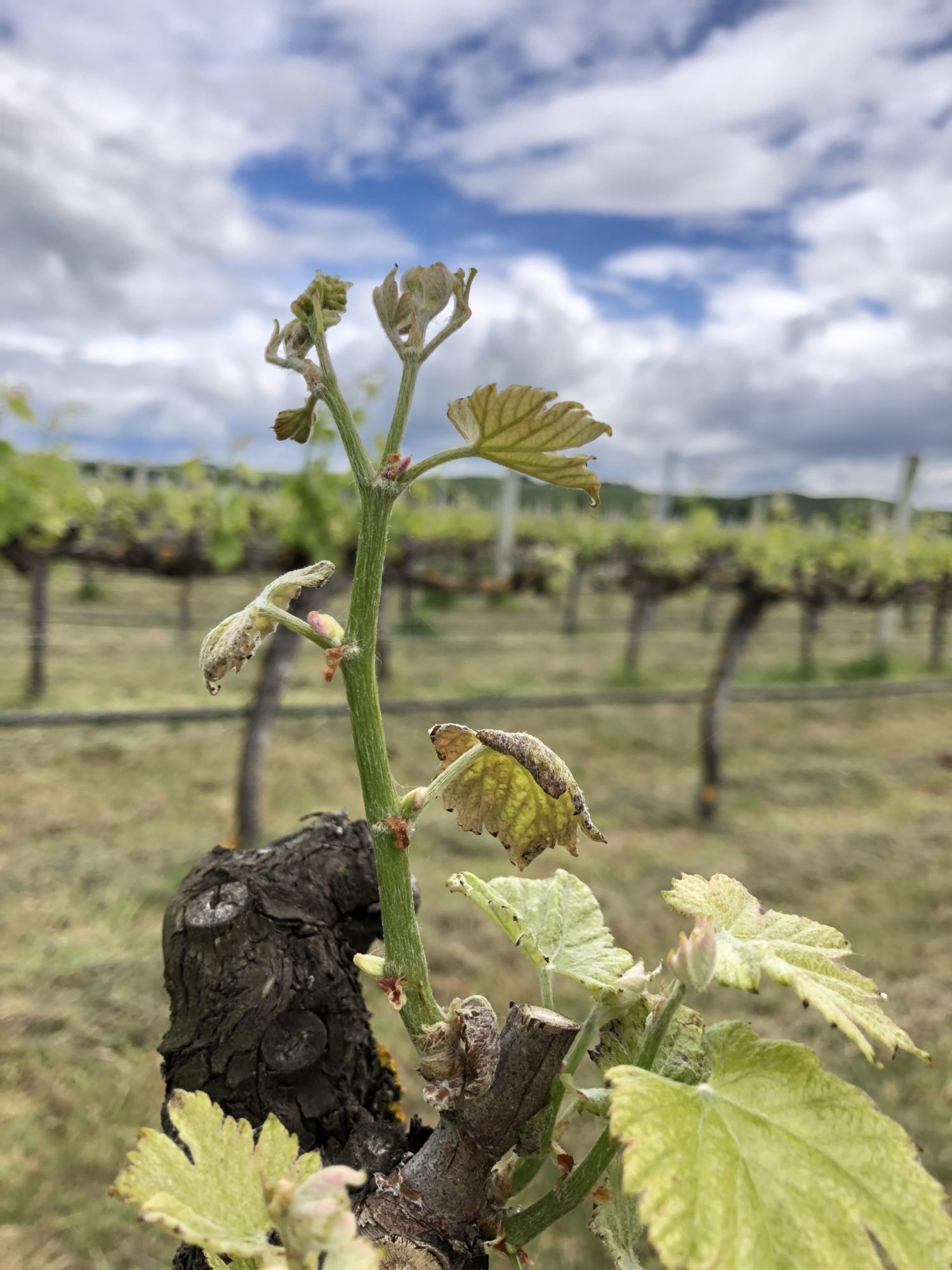
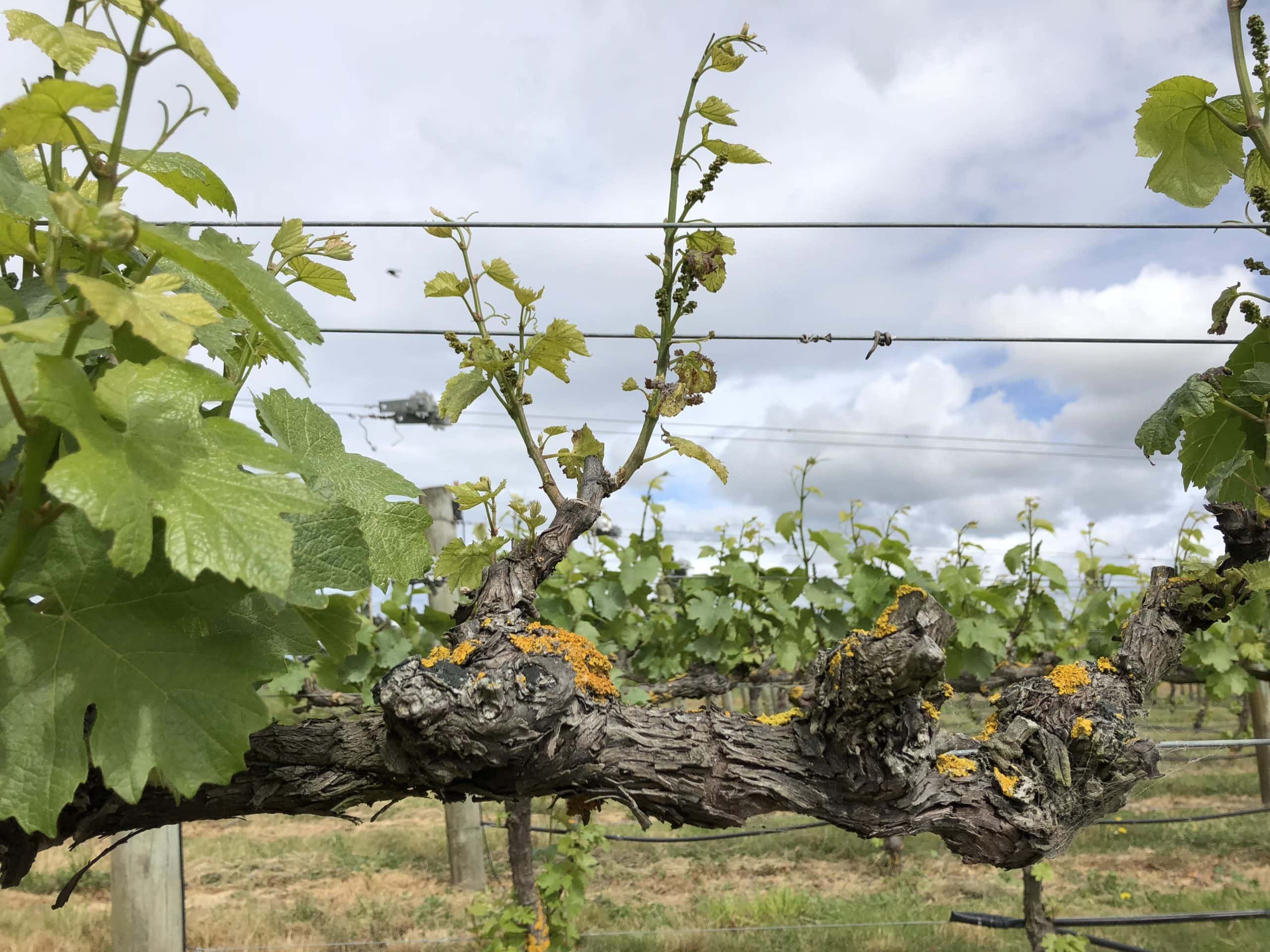
Figure 1. Foliar symptoms of eutypa dieback, including cupped leaves with necrotic margins (left) and stunted shoots on the central spur (right).
Symptoms
Foliar symptoms characteristic of eutypa dieback were observed in vineyards of both regions (Figure 1). Dieback symptoms were also observed, which on cordon spur-pruned vines ranged from two dead spurs to dead arms (Figure 2), and on cane-pruned vines appeared as dead and unproductive sections of heads, dead canes, cankers and completely dead vines (Figure 3).
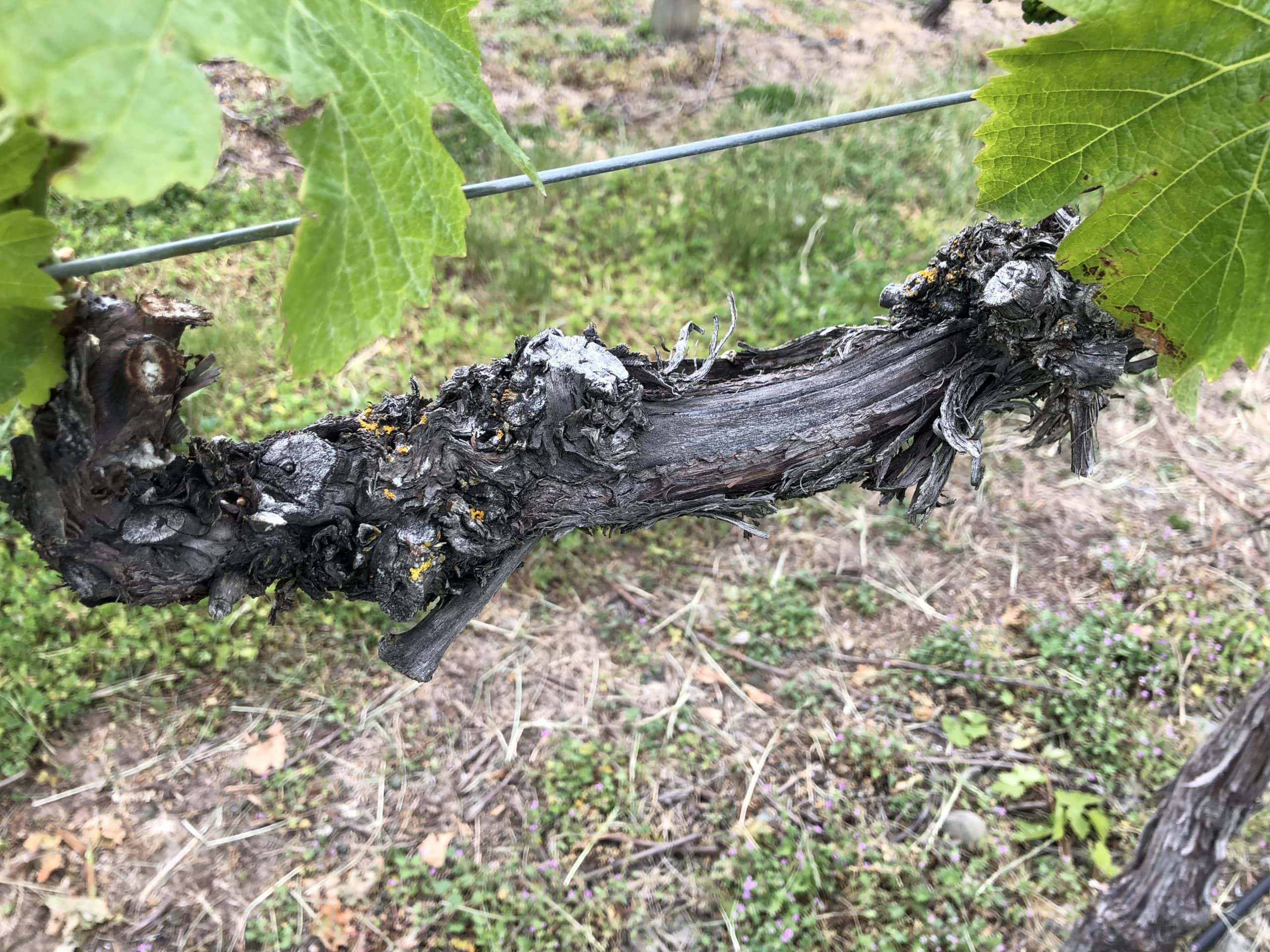

Figure 2. Dieback symptoms on cordon spur-pruned vines, with cankers extending from dead spurs (left) and whole dead arms (right).
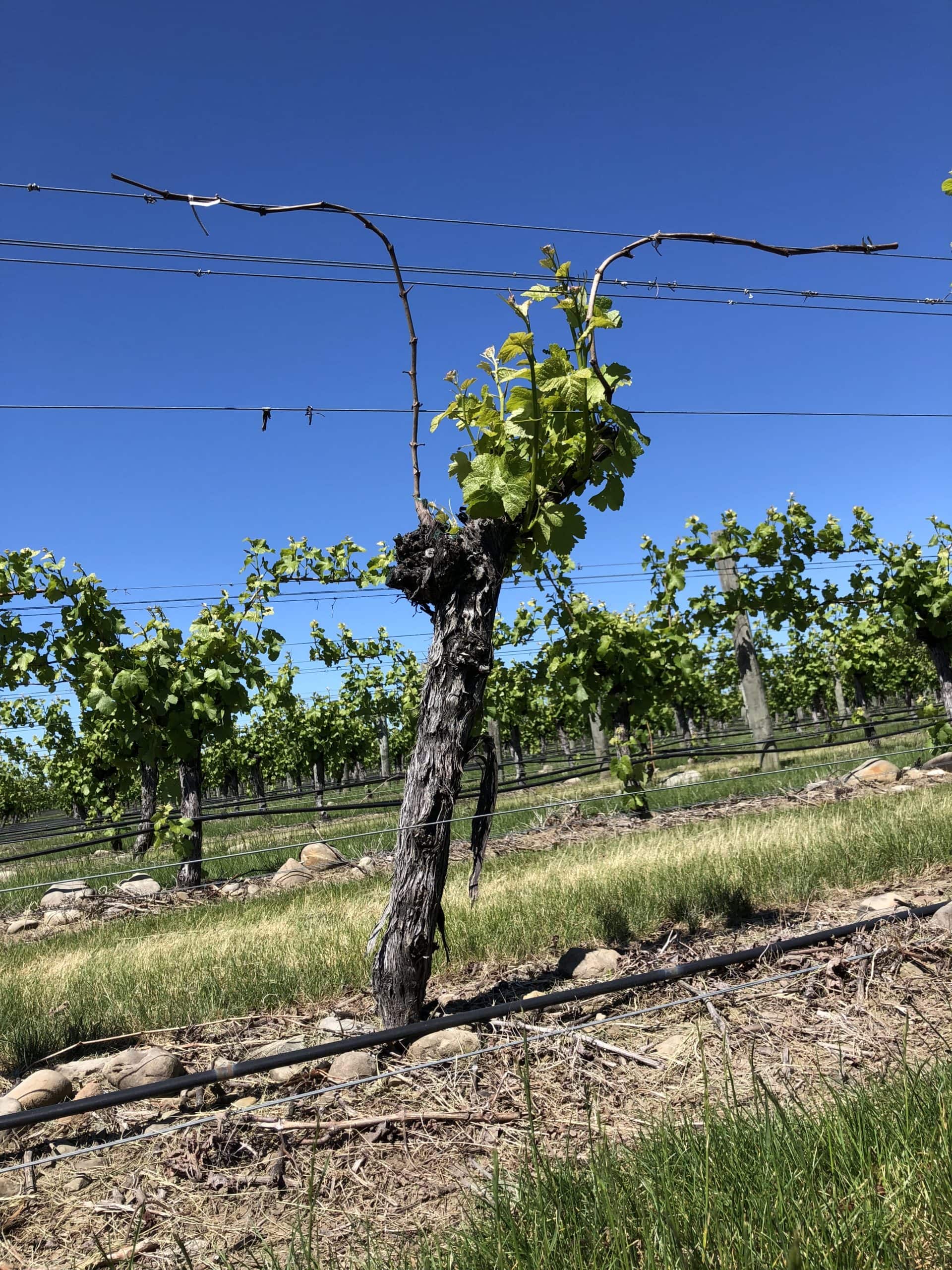
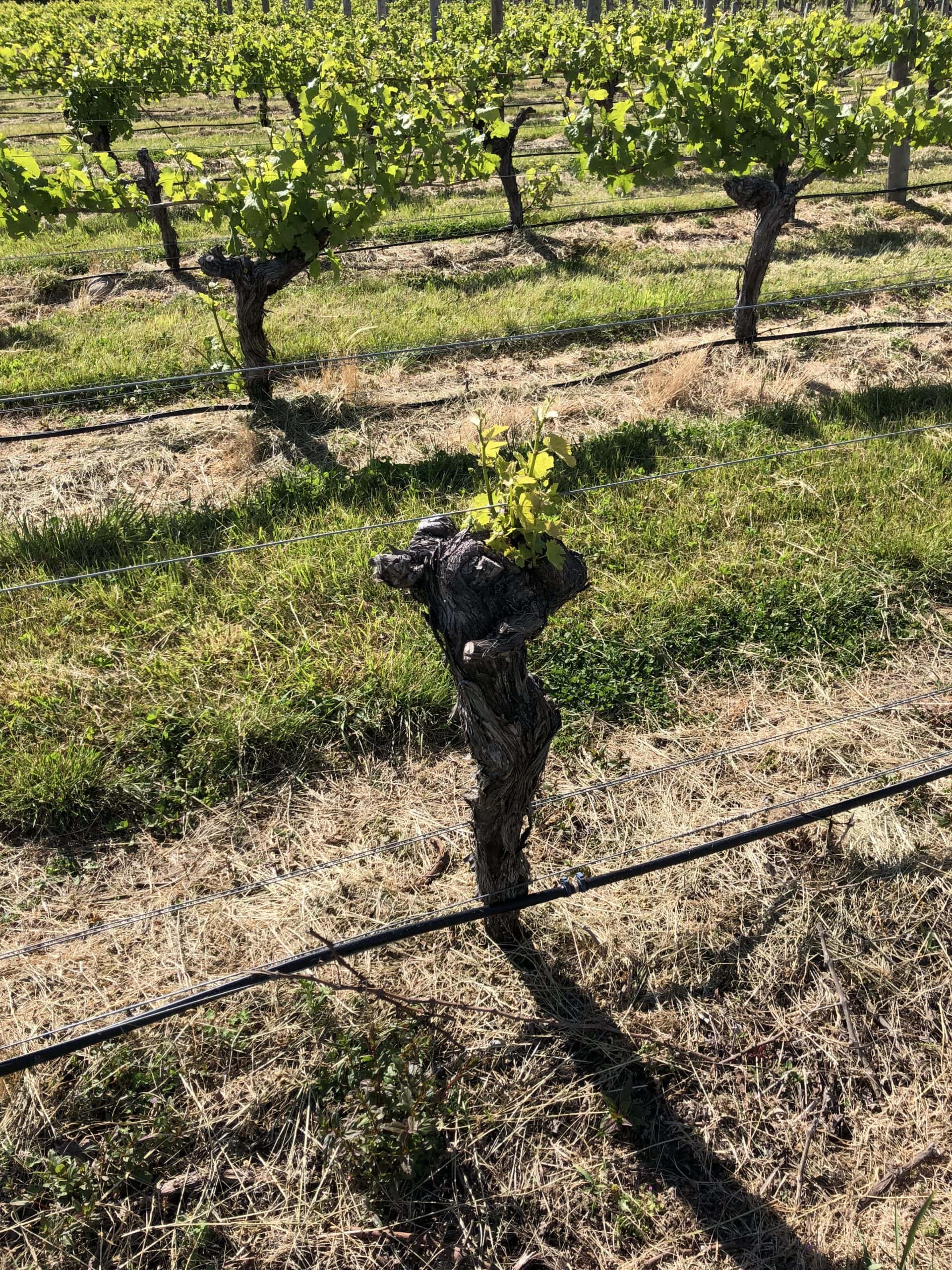

Figure 3. Dieback symptoms on cane-pruned vines, with dead canes (left), unproductive head with only one remaining shoot (middle) and trunk canker extending from a large wound (right)
Effect of age, region and variety
In 2018, the average age of all vineyards surveyed was 17 years, compared with an average of 12 years in the 2013 survey. The overall mean incidence of dieback was 20.2% in 2018 compared with 8.1% recorded in the same vines in 2013. Foliar symptoms were observed in 0.3% of vines in 2018, compared with 0.1% in 2013.
A scatter plot of vine age against incidence of dieback for all blocks is shown in Figure 4. Only vineyards surveyed in 2013 were included in the 2018 survey, so the youngest vines were 9 years old, and some of these were recorded with up to 13% incidence of dieback. Overall, dieback incidence varied greatly, with maximums ranging from 20% for 10-year-old vines to more than 80% for 20-year-old vines. Hawke’s Bay blocks appeared to generally cluster higher on the plot than Marlborough blocks. Linear trend lines indicated that the incidence of dieback increased with age, but was only marginally greater on average in Hawke’s Bay than in Marlborough, and had relatively low correlation (R2 = 0.22–0.37) values because of the large variation. Across both regions, 31 vineyard blocks were recorded with more than 60% incidence of dieback in 2018, compared with only eight blocks in 2013.
Of the commonly planted varieties, Cabernet Sauvignon, Malbec, Syrah and Merlot had average incidences of dieback ranging from 31 to 43%. Chardonnay, Sauvignon Blanc, Riesling, Gewurztraminer and Pinot Noir had average incidences of dieback symptoms ranging from 16 to 22%. Pinot Gris was recorded with 10% incidence, but notably had the lowest average age of 14 years, compared with 16–23 years for all other varieties.

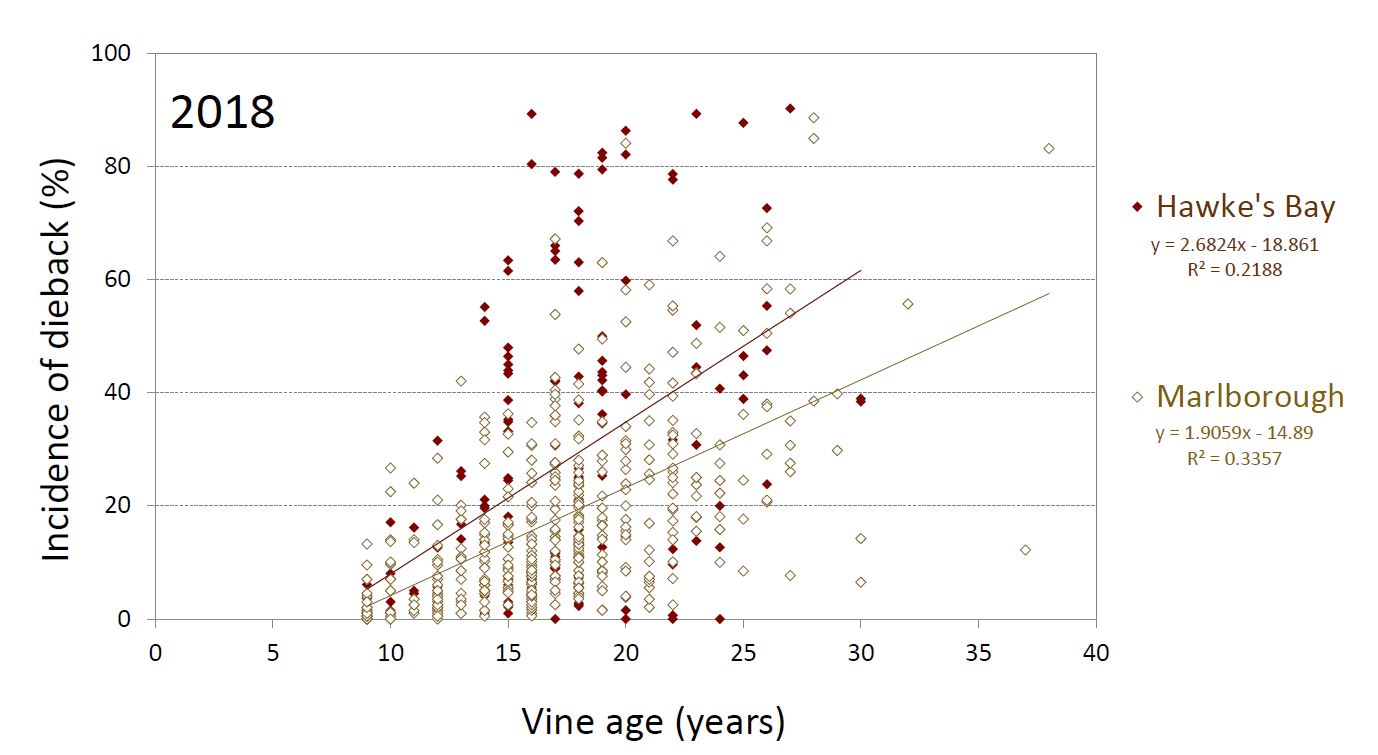
Figure 4. Scatter plot of vine age against incidence of dieback symptoms for all blocks surveyed in each of the regions of Hawke’s Bay and Marlborough, in 2013 and 2018.
Effect of pruning system
In the 2018 survey, 473 blocks were cane-pruned and had an average age of 17 years, compared with 129 that were cordon-pruned and had an average age of 19 years. The average incidence of dieback for cane-pruned vines was 17%, half that for vines cordon-pruned (34%). The greater average incidence of dieback observed in cordon-pruned vines compared with cane-pruned vines, was particularly evident for the varieties Cabernet Sauvignon, Chardonnay and Merlot (Figure 5). In Hawke’s Bay, 41% of all vineyards surveyed were cordon-pruned, compared with 13% in Marlborough.

Figure 5. Incidence of dieback for cane-pruned (blue bars) and cordon-pruned (red bars) vines of the main varieties surveyed in 2018. The number of blocks surveyed for each variety (cane-pruned/ cordon pruned) is shown in parentheses, and the average age of vineyards (years) is indicated in white at the base of each column. Bars represent standard errors of the means.
Effect of clone and rootstock
Average incidence of dieback varied between clones of some varieties surveyed. Clones of Cabernet Sauvignon ranged from 26–80%, Merlot from 20–65%, Pinot Noir from 2–21% and Chardonnay from 16–33%. The average age of vineyards representing each clone ranged from 14–23 years.
Average incidence of dieback also varied on some varieties that were planted on different rootstocks. Sauvignon Blanc ranged from 13–34% on different rootstocks, Pinot Noir from 12–30%, Chardonnay from 11–42%, Pinot Gris from 7–20% and Merlot from 25–35%. The average age of vineyards representing different variety/rootstock combinations ranged from 15–21 years.
Case study – remedial surgery
A group of 14 blocks that were reworked during the 5-year period between the 2013 and 2018 surveys were recorded with decreases in dieback incidence of up to 60%, whereas a group of 14 blocks, with similar age, variety and location were recorded with increases in dieback incidence up to 60%.
Figure 6 shows three examples of comparisons between individual blocks of the same age and variety that were either reworked or not. For each example, in 2013 incidence of dieback was similar in both blocks before remedial surgery. For blocks that were reworked incidence of dieback was reduced to between 1 and 4%, whereas blocks that were not reworked, had increased dieback incidence of between 33 and 65%.

Figure 6. Examples of the effect of remedial surgery on incidence of dieback, comparing vines of the same variety and age, at the time of the 2013 and 2018 surveys, when reworking was undertaken between the two surveys.
Case study – pruning wound protection
A group of 102 blocks were selected that had a well-documented wound protection management programme in place since 2006. In all of these blocks, large wounds (>25 mm) were consistently covered with registered wound paints following pruning up until 2012, and then from 2013, all wounds, regardless of size, were protected each year. These blocks were aged between 9 and 21 years in 2018, so vines under 12 years of age have had wound protection since they were planted, and the oldest vines have had wound protection since 10 years of age. Figure 7 shows scatter plots of the incidence of dieback infection in 2018 for all vines (top), and for the 102 blocks with wound protection management programme (bottom). Across all blocks, the maximum incidence of dieback infection increased with increasing vine age (from 20% in 10-year-old vines to 80% in 20-year-old vines), whereas in the subset of blocks under active wound management the maximum incidence of dieback infection did not increase with vine age (up to 20% at all ages).

Figure 7. Scatter plots of the incidence of dieback in all blocks surveyed in 2018 (top) and the 102 blocks (bottom) with active pruning wound protection management in place since 2006 in Hawke’s Bay and Marlborough . Blue lines indicate the maximum dieback incidence for vines aged between 10 and 20 years.
Discussion
In the 2013 survey, the overall incidence of dieback was 8% when the average age of vines was 12 years, and in 2018 the incidence in the same blocks increased to 20% when the average age of vines was 17 years. With the trend of increase over the past 5 years, it is reasonable to expect that there will be a further increase in incidence of trunk disease symptoms in this sample of vineyard blocks in the future if management strategies are not widely implemented.
The fungi that cause ED and BD progress and kill mature grapevine wood at anywhere from 10 to 80 mm/year, depending on the species and variety, so it can take many years for external dieback symptoms to become visible. Similarly, foliar symptoms of ED take 3 to 8 years to manifest after infection has occurred. Therefore the observation of symptoms in vines as young as 4 years of age in these surveys, suggests that infection may have occurred in the first year of vineyard production, and highlights the importance of early adoption of wound protection.
Observations during the 2018 survey, indicated that Cabernet Sauvignon, Malbec, Syrah and Merlot were the varieties most susceptible to trunk disease. Chardonnay, Sauvignon Blanc, Riesling and Gewurztraminer were moderately susceptible and Pinot Gris and Pinot Noir were the least susceptible. In general, these results support previous research and surveys on susceptibility of varieties to GTDs in other countries. However, exceptions to this were Merlot, which is widely reported as tolerant to trunk diseases, and Sauvignon Blanc, reported as highly susceptible. In the current survey, Merlot blocks had an average age of 19 years and were predominantly cordon-pruned, whereas Sauvignon Blanc blocks had an average age of 16 years and were predominantly cane-pruned. Cordon-pruned vines are reported to express more trunk disease symptoms in vines under 20 years of age than cane-pruned vines, which may explain the contradiction. On the other hand, previous research reported that Merlot cuttings developed longer lesions than Sauvignon Blanc when inoculated with BD pathogens in New Zealand, so perhaps disease susceptibility differs under New Zealand conditions.
Incidence of dieback symptoms was marginally greater in Hawke’s Bay than in Marlborough. As the average age of vineyards in both regions was similar (17 years) and annual rainfall is 700–800 mm/year in both regions (www.niwa.co.nz), the most likely reason for the difference is the greater use of cordon pruning in Hawke’s Bay. It was observed in this survey that cordon-pruned vines had a greater incidence of dieback than cane-pruned vines, particularly for Cabernet Sauvignon, Chardonnay and Merlot. In a French trial, comparing cordon- and cane-pruning, it was reported that, at the age of 10 years, foliar symptoms of ED were more prevalent in cordon-pruned vines, but after 20 years, greater mortality was reported in cane-pruned vines. Therefore symptoms are expected to be visible earlier on cordon-pruned vines, which have greater numbers and surface areas of pruning wounds than cane-pruned vines. However, large wounds located on the crown of cane-pruned vines can lead to trunk infection, causing vine death in mature vines with fewer visible external symptoms. Based on this knowledge, it is anticipated that the incidence of dieback and death of vines from trunk disease will increase significantly in Marlborough over the next 5 years, as it is predominated with cane-pruned Sauvignon Blanc.
Relationships between vine age and incidence of dieback were relatively low, indicating that variables other than age and variety may affect the incidence of trunk disease symptoms. Clones and rootstocks varied in incidence of dieback, but results may be confounded by age differences and limited numbers of representative blocks. Further scientific investigation is required to evaluate commonly used rootstocks, which are inoculated with eutypa and botryosphaeria pathogens, to determine whether clones and rootstocks vary in susceptibility to trunk disease. This information could eventually provide decision support for new plantings, which may reduce the impact of GTD for vineyard longevity.
The case study for remedial surgery revealed short-term success of this strategy. It will be important to continue following the progress of these blocks in future to confirm longer-term success of remedial surgery. Many factors can affect the success of remedial surgery, and if all visible disease is not removed from trunks, life expectancy will be limited. New research is commencing as part of the Vineyard Ecosystems programme to further evaluate remedial surgery, including attempting to gain a better understanding of how disease progresses in trunks to better inform the industry on appropriate timing so as to maximise success and, in turn, vineyard longevity.
The case study for pruning wound protection provides some confirmation on the effect of protecting pruning wounds in the vineyard. A recently completed project (NZW 13-100) developed practical and efficient methods for the protection of pruning wounds against infection by identifying effective fungicides that can be applied with tractor-driven sprayers. If this becaome a routine practice in New Zealand vineyards it has the potential to save $20 million each year, and furthermore, with the use of remedial surgery could save a further $20 million annually.
It is recommended that this survey be repeated in 5 years to continue monitoring the disease incidence and impact of management strategies. New vineyard blocks should be added to the current list of vineyards surveyed in 2013 and 2018, to represent a spectrum of vineyard ages and assess the levels of disease in young vineyards. Furthermore, a targeted survey on vineyards under active management for GTDs may further confirm the success of remedial surgery and wound protection strategies.
This article first appeared in the August/September 2019 issue of New Zealand Winegrowers magazine

















